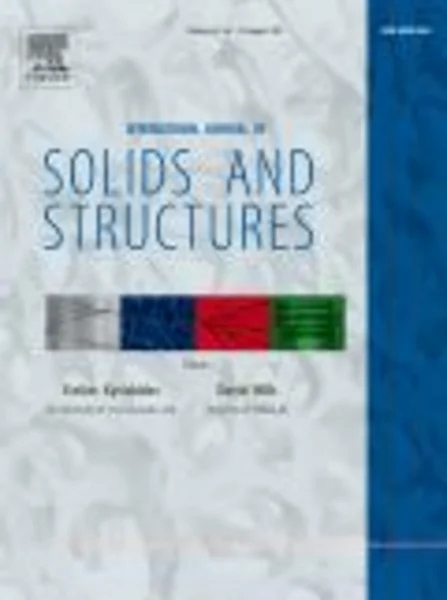-
equivalent properties of monolayer fabric from mesoscopic modelling strategies
جزئیات بیشتر مقاله- تاریخ ارائه: 1392/01/01
- تاریخ انتشار در تی پی بین: 1392/01/01
- تعداد بازدید: 675
- تعداد پرسش و پاسخ ها: 0
- شماره تماس دبیرخانه رویداد: -
a general and systematic approach for the development of mesostructurally-based continuum model of woven fabrics has been elaborated, relating the fabric behavior at the macroscopic continuum scale to the response and geometry of the fabric’s mesostructure (geometrical configuration of the weave and the yarn properties). mesoscopic discrete models of dry fabric have been developed based on a discretization of the yarn geometry, accounting for the yarn–yarn interactions at the yarns crossing points. the yarns are modeled within a unit cell consisting of the repetitive fabric pattern as curved planar beams submitted to the reaction forces of the transverse yarns at discrete crossover points. those reaction forces are expressed in semi-analytical form versus the yarn geometry and mechanical properties for general armour from beam theory. the equilibrium shape of the woven fabric is obtained by minimizing its total potential energy, accounting for the work of the reaction forces due to the transverse yarns. the absolute minimum of the structure’s total potential energy is achieved by a classical genetic algorithm. simulation results show that plain weave presents a nonlinear response in the early deformation stage due to the crimp change, whereas twill shows a quasi linear response due to yarn extension being the dominant deformation mechanism. plain weave fabric overall exhibits an orthotropic constitutive law, as biaxial simulations show. the transverse behavior of plain weave fabric is presently evaluated in terms of poisson’s ratio, based on virtual simulations at the mesoscopic scale of analysis. simulation results show that poisson’s ratio first increases towards a maximum due to the rapid shrinkage of the sample in the transverse direction, and decreases thereafter when the crimp changes become limited by the reaction forces of the transverse yarns. the influence of the mechanical properties of both warp and weft on poisson’s coefficient is assessed. the predictions of the mesoscopic models regarding the impact of yarn geometry and mechanical properties on the overall behavior provide a guideline for the design of woven fabrics.
مقالات جدیدترین رویدادها
-
استفاده از تحلیل اهمیت-عملکرد در ارائه الگوی مدیریت خلاقیت سازمانی و ارائه راهکار جهت بهبود
-
بررسی تاثیر ارزش وجوه نقد مازاد بر ساختار سرمایه شرکت های پذیرفته شده در بورس اوراق بهادار تهران
-
بررسی تأثیر سطح افشای ریسک بر قرارداد بدهی شرکت های پذیرفته شده در بورس اوراق بهادار تهران
-
بررسی تأثیر رتبه بندی اعتباری مبتنی بر مدل امتیاز بازار نوظهور بر نقد شوندگی سهام با تأکید بر خصوصی سازی شرکت ها
-
تأثیر آمیخته بازاریابی پوشاک ایرانی بر تصویر ذهنی مشتری پوشاک ایرانی (هاکوپیان)
-
تاثیر روتنیم برروی کاتالیست co/γ-al2o3 در راکتور cstr در سنتز فیشر-تروپش
-
نیاز به طراحی شهری بهتر با هدف زیستگاهی پایدار
-
تاثیر زبری منقطع در تعیین ضرایب هیدرودینامیکی موثر بر شمع با استفاده از روش های تحلیلی مختلف
-
road safety risk evaluation and target setting using data envelopment analysis and its extensions
-
creep behavior of the intact and meniscectomy knee joints
مقالات جدیدترین ژورنال ها
-
مدیریت و بررسی افسردگی دانش آموزان دختر مقطع متوسطه دوم در دروان کرونا در شهرستان دزفول
-
مدیریت و بررسی خرد سیاسی در اندیشه ی فردوسی در ادب ایران
-
واکاوی و مدیریت توصیفی قلمدان(جاکلیدی)ضریح در موزه آستان قدس رضوی
-
بررسی تاثیر خلاقیت، دانش و انگیزه کارکنان بر پیشنهادات نوآورانه کارکنان ( مورد مطالعه: هتل های 3 و 4 ستاره استان کرمان)
-
بررسی تاثیر کیفیت سیستم های اطلاعاتی بر تصمیم گیری موفق در شرکتهای تولیدی استان اصفهان (مورد مطالعه: مدیران شرکتهای تولیدی استان اصفهان)
-
اثربخشی درمان مثبت نگر بر کاهش علائم افسردگی و اضطراب در زنان باردار
-
احیای بناهای تاریخی، راهکاری برای نیل به پایداری فرهنگی - اجتماعی و اقتصادی شهرها
-
گونه شناسی خط مشی های دومنظوره سازی صنعت دفاعی ایران
-
بررسی اثرات متقابل متغیرهای تورم، تولید و نرخ ارز در اقتصاد ایران: رویکرد الگوی معادلات همزمان
-
بررسی آثار و رویکردهای مرتبط با تعیین زمان و مکان شکل گیری قراردادهای الکترونیک




سوال خود را در مورد این مقاله مطرح نمایید :